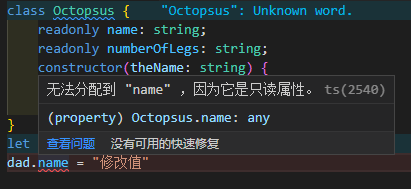1、默认是public
自由的访问程序里定义的成员
class Parent {
public name: string;
constructor(theName: string) {
this.name = theName;
}
}
let a = new Parent("张三").name;
2、private
私有,不能在声明它的类的外部访问,如下
class Parent {
private name: string;
constructor(theName: string) {
this.name = theName;
}
}
let a = new Parent("张三").name; //属性"name"为私有属性,只能在类"Parent"中访问。

3、protected
受保护成员只能在类及其子类中访问,而不能在类的实例中访问
class Parent {
protected name: string;
constructor(theName: string) {
this.name = theName;
}
}
let a = new Parent("张三").name;//属性"name"受保护,只能在类"Super及其子类中访问"

class Parent {
protected name: string;
constructor(theName: string) {
this.name = theName;
}
}
// let a = new Parent("张三").name;
class Cat extends Parent {
constructor(theName: string) {
super(theName);
this.name = '张三,'
}
}
4、readonly修饰符
class Octopsus {
readonly name: string;
readonly numberOfLegs: string;
constructor(theName: string) {
this.name = theName
}
}
let dad = new Octopsus('张三');
dad.name = "修改值" //无法分配到"name",因为它是只读属性。

5、static
类的静态成员只能通过类名来调用,二不能通过子类调用
class Octopus {
public name: string;
constructor(theName: string) {
this.name = theName
}
static food = "fish"
}
console.log(Octopus.food)
参考文档:https://typescript.bootcss.com/classes.html